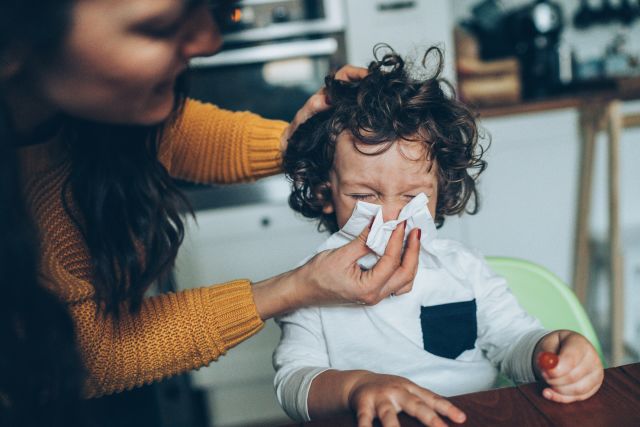Updated on March 30, 2023.
Children face a wide range of respiratory viruses, including those that cause colds, flu, and COVID-19. One you may not have heard about as much is enterovirus. On occasion, outbreaks of this virus send children to the hospital, including some to the intensive care unit (ICU).
A particularly severe strain is called enterovirus D68 (also called EV-D68). Outbreaks of EV-D68 have been reported in recent years, including 2014, 2016, 2018, and 2020.
Here’s what to know about this virus and what you can do to protect your family.
What is EV-D68?
Enterovirus D68 is a rare virus most commonly found in children. The virus belongs to a family of more than 100 non-polio enteroviruses that cause 10 to 15 million infections in the United States each year. While many enteroviruses cause gastrointestinal symptoms (like vomitting or diarrhea), enterovirus D68 primarily causes respiratory symptoms (like congestion, runny nose, sore throat, coughing) due to its genetic similarities to rhinovirus (the most frequent cause of the common cold).
Usually, non-polio enteroviruses like EV-D68 just cause a bad cold and don’t need a trip to the emergency room, or hospitalization. In rare cases, however, enteroviruses can cause other illnesses such as a rash with fever and more severe illness such as viral meningitis and encephalitis (inflammatory diseases of the tissue that surrounds the brain and spinal cord). Enteroviruses tend to spread in summer and fall, but they can cause infections year-round.
What are the symptoms?
Infection with enterovirus D68 initially starts as a cold, maybe with a cough. Most children with common cold symptoms will be fine and not need to go to the hospital. But if your child is younger than 5, or has allergies, asthma, or any other chronic medical condition, they are at higher risk of severe illness or complications.
What are the red flags to watch for?
If your child has difficulty breathing, see a healthcare provider (HCP) right away. Signs of difficulty breathing include:
- Breathing rapidly: Children under 12 months usually breathe about 35 to 45 times per minute. Children between the ages of one and two breathe at rates in the 30s. Kids who are 3 to 8 years old usually breathe at rates in the 20s. Rates higher than that can be a red flag.
- Flaring nostrils
- Straining of the breathing muscles: This may be visible in the neck, above the collarbone, between the ribs, or in the abdomen
- Wheezing
If your child has a high fever, that’s another warning sign that needs medical attention. The same goes for if they are lethargic, experiencing muscle weakness in an arm or leg, having trouble walking, if they have droopy eyelids or face, or if they complain of pain in the neck, back, or limbs. If they have these symptoms or develop any other concerning signs, seek medical care. Children with bad allergies and asthma should also be seen by an HCP.
What’s the treatment?
There’s no specific cure for EV-D68. As with many viral illnesses, the key is supportive care, which means giving the body what it needs to support its natural efforts to fend off the virus, such as rest and plenty of fluids. In cases requiring hospitalization, care might include IV fluids and breathing treatments. More severe cases might require breathing tubes and ventilators to help the patient breathe while the body has time to heal.
Can enterovirus D68 be prevented?
There is currently no vaccine for EV-D68. But since the virus is spread through close contact—and transmitted via coughing, sneezing, or touching contaminated surfaces—there are some things you can do to keep your family healthy. Some of them may seem difficult with small children, which is why that age group is so prone to spreading and catching this and other contagious infections. Include these prevention basics in your routine:
- Wash your hands in hot, soapy water for at least 20 seconds, especially after going to the bathroom or changing diapers. Help younger children wash their hands and remind older children of the importance of thorough hand washing with soap.
- Clean and disinfect surfaces regularly touched by multiple people, such as doorknobs and refrigerator handles.
- Teach children to cough and sneeze into their shirt sleeve or a tissue, not their hands.
- Regularly disinfect children’s school supplies, such as pencils, and encourage kids not to share them.
- Stay home, or keep your child home, if you or your child is sick.
- Avoid sharing eating utensils like cups and avoid close physical contact with anyone who is sick.
- Avoid touching your face with unwashed hands.

